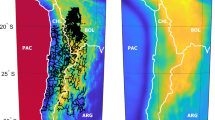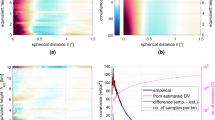Abstract
Collocation is widely used in physical geodesy. Its application requires to solve systems with a dimension equal to the number of observations, causing numerical problems when many observations are available. To overcome this drawback, tailored step-wise techniques are usually applied. An example of these step-wise techniques is the space-wise approach to the GOCE mission data processing. The original idea of this approach was to implement a two-step procedure, which consists of first predicting gridded values at satellite altitude by collocation and then deriving the geo-potential spherical harmonic coefficients by numerical integration. The idea was generalized to a multi-step iterative procedure by introducing a time-wise Wiener filter to reduce the highly correlated observation noise. Recent studies have shown how to optimize the original two-step procedure, while the theoretical optimization of the full multi-step procedure is investigated in this work. An iterative operator is derived so that the final estimated spherical harmonic coefficients are optimal with respect to the Wiener–Kolmogorov principle, as if they were estimated by a direct collocation. The logical scheme used to derive this optimal operator can be applied not only in the case of the space-wise approach but, in general, for any case of step-wise collocation. Several numerical tests based on simulated realistic GOCE data are performed. The results show that adding a pre-processing time-wise filter to the two-step procedure of data gridding and spherical harmonic analysis is useful, in the sense that the accuracy of the estimated geo-potential coefficients is improved. This happens because, in its practical implementation, the gridding is made by collocation over local patches of data, while the observation noise has a time-correlation so long that it cannot be treated inside the patch size. Therefore, the multi-step operator, which is in theory equivalent to the two-step operator and to the direct collocation, is in practice superior thanks to the time-wise filter that reduces the noise correlation before the gridding. The criteria for the choice of this filter are investigated numerically.
Similar content being viewed by others
References
Albertella A, Migliaccio F, Reguzzoni M, Sansò F (2004) Wiener filters and collocation in satellite gradiometry. In: Sansò F (ed) International association of geodesy symposia, “V Hotine–Marussi symposium on mathematical geodesy”, 17–21 June 2002, Matera, Italy, vol 127. Springer, Berlin, pp 32–38
Alkhatib H, Schuh WD (2007) Integration of the Monte Carlo covariance estimation strategy into tailored solution procedures for large-scale least squares problems. J Geod 81: 53–66. doi:10.1007/s00190-006-0034-z
Andritsanos VD, Sideris MG, Tziavos IN (2001) Quasi-stationary sea surface topography estimation by the multiple input/output method. J Geod 75: 216–226. doi:10.1007/s001900100169
Arabelos D, Tscherning CC (2007) On a strategy for the use of GOCE gradiometer data for the development of a geopotential model by LSC. In: Proceedings of the 3rd international GOCE user workshop, 6–8 November 2006, Frascati, Italy (ESA SP-627, January 2007), pp 69–75. ISBN 92-9092-938-3, ISSN 1609-042X
Basilevsky A (1983) Applied matrix algebra in the statistical sciences. Dover Publications, New York
Blackman RB, Tukey JW (1958) The measurement of power spectra from the point of view of communications engineering. Dover Publications, New York
Bouman J, Rispens S, Koop R (2007) GOCE gravity gradients for use in Earth sciences. In: Proceedings of the 3rd international GOCE user workshop, 6-8 November 2006, Frascati, Italy, (ESA SP-627, January 2007), pp 135–139. ISBN 92-9092-938-3, ISSN 1609-042X
Bronshtein IN, Semendyayev KA, Musiol G, Muehlig H (2004) Handbook of mathematics. Springer, Berlin
Bruinsma S, Marty JC, Balmino G (2004) Numerical simulation of the gravity field recovery from GOCE mission data. In: Proceedings of the 2nd international GOCE user workshop, 8–10 March 2004, Frascati, Italy, (ESA SP-569, June 2004). ISBN 92-9092-880-8, ISSN 1609-042X
Catastini G, Cesare S, De Sanctis S, Dumontel M, Parisch, Sechi G (2007) Predictions of the GOCE in-flight performances with the end-to-end system simulator. In: Proceedings of the 3rd international GOCE user workshop, 6–8 November 2006, Frascati, Italy, (ESA SP-627, January 2007), pp 9–16. ISBN 92-9092-938-3, ISSN 1609-042X
Colombo OL (1981) Numerical methods for harmonic analysis on the sphere. Report No. 310, Department of Geodetic Science and Surveying, Ohio State University, Columbus
Drinkwater RM, Haagmans R, Muzi D, Popescu A, Floberghagen R, Kern M, Fehringer M (2007) The GOCE gravity mission: ESA’s first core Earth explorer. In: Proceedings of the 3rd international GOCE user workshop, 6–8 November 2006, Frascati, Italy, (ESA SP-627, January 2007), pp 1–7. ISBN 92-9092-938-3, ISSN 1609-042X
ESA (1999) Gravity field and steady-state ocean circulation mission. ESA SP-1233 (1). ESA Publication Division, c/o ESTEC, Noordwijk
Förste Ch, Flechtner F, Schmidt R, König R, Meyer U, Stubenvoll R, Rothacher M, Barthelmes F, Neumayer H, Biancale R, Bruinsma S, Lemoine JM, Loyer S (2007) Global mean gravity field models from combination of satellite mission and altimetry/gravimetry surface data. In: Proceedings of the 3rd international GOCE user workshop, 6–8 November 2006, Frascati, Italy, (ESA SP-627, January 2007), pp 163–167. ISBN 92-9092-938-3, ISSN 1609-042X
Gruber T, Rummel R, Koop R (2007) How to use GOCE level 2 products. In: Proceedings of the 3rd international GOCE user workshop, 6–8 November 2006, Frascati, Italy (ESA SP-627, January 2007), pp 205–211. ISBN 92-9092-938-3, ISSN 1609-042X
Jekeli C (1998) Error analysis of padding schemes for DFT’s of convolutions and derivatives. Report No. 446, Department of Civil and Environmental Engineering and Geodetic Science, The Ohio State University, Columbus
Jekeli C (1999) The determination of gravitational potential differences from satellite-to-satellite tracking. Celestial Mech Dyn Astron 75: 85–101
Klees R, Ditmar P, Broersen P (2003) How to handle colored observation noise in large least-squares problems. J Geod 76: 629–640. doi:10.1007/s00190-002-0291-4
Lemoine FG, Kenyon SC, Factor JK, Trimmer RG, Pavlis NK, Chinn DS, Cox CM, Klosko SM, Luthcke SB, Torrence MH, Wang YM, Williamson RG, Pavlis EC, Rapp RH, Olson TR (1998) The development of the joint NASA GSFC and NIMA geopotential model EGM96, NASA Tech Rep, 1998-206861, Greenbelt
Migliaccio F, Reguzzoni M, Sansò F (2004a) Space-wise approach to satellite gravity field determination in the presence of coloured noise. J Geod 78: 304–313. doi:10.1007/s00190-004-0396-z
Migliaccio F, Reguzzoni M, Sansò F, Tscherning CC (2004b) The performance of the space-wise approach to GOCE data analysis, when statistical homogenization is applied. Newton’s Bull 2: 60–65
Migliaccio F, Reguzzoni M, Tselfes N (2006) GOCE: a full-gradient simulated solution in the space-wise approach. In: Tregoning P, Rizos C (eds) International association of geodesy symposia, “dynamic planet—monitoring and understanding a dynamic planet with geodetic and oceanographic tools”, IAG2005 - Scientific Assembly, 22–26 August 2005, Cairns, Australia, vol 130. Springer, Berlin, pp 383–390
Migliaccio F, Reguzzoni M, Sansò F, Tselfes N, Tscherning CC, Veicherts M (2007a) The latest of the space-wise approach for GOCE data analysis. In: Proceedings of the 3rd international GOCE user workshop, 6–8 November 2006, Frascati, Italy (ESA SP-627, January 2007), pp 241–248. ISBN 92-9092-938-3, ISSN 1609-042X
Migliaccio F, Reguzzoni M, Sansò F, Tselfes N (2007b) On the use of gridded data to estimate potential coefficients. In: Proceedings of the 3rd international GOCE user workshop, 6–8 November 2006, Frascati, Italy (ESA SP-627, January 2007), pp 311-318. ISBN 92-9092-938-3, ISSN 1609-042X
Migliaccio F, Reguzzoni M, Sansò F, Tselfes N (2007c) An error model for the GOCE space-wise solution by Monte Carlo methods. In: Proceedings of the XXIV IUGG general assembly, 2–13 July 2007, Perugia, Italy (in press)
Pail R, Schuh WD, Wermuth M (2005) GOCE gravity field processing. In: Jekeli C, Bastos L, Fernandes J(eds) International association of geodesy symposia, “gravity, geoid and space missions”, vol 129. Springer, Berlin, pp 36–41
Papoulis A (1984) Signal analysis. McGraw Hill, New York
Reguzzoni M (2003) From the time-wise to space-wise GOCE observables. Adv Geosci 1: 137–142
Reguzzoni M, Tselfes N, Venuti G (2006) Stepwise solutions to random field prediction problems. In: Proceedings of the 6th Hotine–Marussi symposium on mathematical geodesy, Wuhan, China, 29 May – 2 June, 2006 (in press)
Rummel R, Gruber T, Koop R (2004) High level processing facility for GOCE: products and processing strategy. In: Proceedings of the 2nd international GOCE user workshop, 8–10 March 2004, Frascati, Italy, (ESA SP-569, June 2004). ISBN 92-9092-880-8, ISSN 1609-042X
Sansò F, Sideris MG (1997) On the similarities and differences between system theory and least-squares collocation in physical geodesy. Boll Geod Sci Affin, Anno LVI 2: 173–206
Schuh WD (1996) Tailored numerical solution strategies for the global determination of the Earth’s gravity field, Folge 81, Mitteilungen der geodätischen Institut der Technischen Universität Graz
Sideris MG (1996) On the use of heterogeneous noisy data in spectral gravity field modeling methods. J Geod 70: 470–479. doi:10.1007/BF00863619
Sneeuw N, van Gelderen M (1997) The polar gap. In: Sansò F, Rummel R(eds) Geodetic boundary value problems in view of the one centimeter geoid. Lecture Notes in Earth Sciences, vol 65. Springer, Heidelberg, pp 559–568
Tscherning CC (1976a) Computation of the second–order derivatives of the normal potential based on the representation by a Legendre series. Manuscripta Geodaetica 1: 71–92
Tscherning CC (1976b) On the chain-rule method for computing potential derivatives. Manuscripta Geodaetica 1: 125–141
Tscherning CC (1993) Computation of covariances of derivatives of the anomalous gravity potential in a rotated reference frame. Manuscripta Geodaetica 18(3): 115–123
Tscherning CC (2001) Computation of spherical harmonic coefficients and their error estimates using least squares collocation. J Geod 75: 12–18. doi:10.1007/s001900000150
Tscherning CC, Rapp RH (1974) Closed covariance expressions for gravity anomalies, geoid undulations, and deflections of the vertical implied by anomaly degree–variance models. Report No. 208, Department of Geodetic Science, Ohio State University, Columbus
Visser PNAM, Sneeuw N, Gerlach C (2003) Energy integral method for gravity field determination from satellite orbit coordinates. J Geod 77: 207–216. doi:10.1007/s00190-003-0315-8
Visser PNAM, van den IJssel J, van Helleputte T, Bock H, Jaeggi A, Beutler G, Hugentobler U, Svehla D (2007) Rapid and precise science orbit determination for the GOCE satellite. In: Proceedings of the 3rd international GOCE user workshop, 6–8 November 2006, Frascati, Italy (ESA SP-627, January 2007), pp 235–239. ISBN 92-9092-938-3, ISSN 1609-042X
Author information
Authors and Affiliations
Corresponding author
Rights and permissions
About this article
Cite this article
Reguzzoni, M., Tselfes, N. Optimal multi-step collocation: application to the space-wise approach for GOCE data analysis. J Geod 83, 13–29 (2009). https://doi.org/10.1007/s00190-008-0225-x
Received:
Accepted:
Published:
Issue Date:
DOI: https://doi.org/10.1007/s00190-008-0225-x




